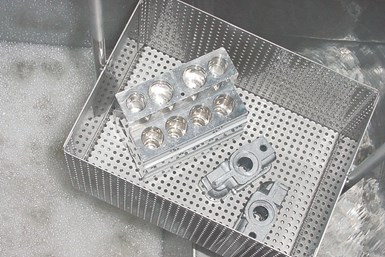Removing Particulate Contaminants from a Cleaning System
Appears in Print as: 'Get the Dirt Out'
Employing the most appropriate technique and a correctly designed system for maintaining bath quality can lower cleaning costs.
Contributed by

Maintaining cleaning fluids within a cleaning system is a reliable path to gaining clean parts like these.
Maybe you have seen it, too: Somebody is cleaning an entire house using only one bucket of water. The more the person has cleaned, the less clean the surfaces are. The dirt wiped off accumulates in the cleaning fluid and is dispersed on the already dirty surfaces.
The same applies in industrial parts cleaning, only it is costly, unproductive and unsustainable to replace the fluid after cleaning only a few parts. Maintaining the fluid quality is therefore an important step to keep in industrial cleaning processes. For removing particulate and film-like contaminants from cleaning fluids, different methods are available. The decision on which should be used, depends on cleanliness requirements, type and amount of impurities and on the cleaning agent—solvent or aqueous.
Featured Content
Modern, fully closed vacuum solvent cleaning systems are equipped with a distillation unit for continuously and automatically removing oils and greases. This allows for recirculation of the used solvent, thus ensuring a long solvent life and low consumption. Additionally, workers don’t get in contact with the solvent. With these systems, the removal of particulates, such as swarf, chips and burrs, is usually performed by full-flow filtration systems. They are integrated directly into fluid loops and equipped with bag filters and multiple tube filters, for example. In case high amounts of metal particulates are brought into the solvent, a magnetic separator can be integrated into the filter system as well. A combination of various filters may make good sense, depending upon the required degree of cleanliness. In particular with multi-shift operations, it’s best to lay out the filters as a double system. This makes it possible to switch from one system to the other while production is running, and the currently unused filter system can then be cleaned.
Full-flow filtration systems with bag and multiple tube filters, as well as magnetic separators, are also used in aqueous cleaning systems for removing particulate contaminants. In addition, various bypass filtration systems with special properties are employed. These include coalescence separators, which are widely used as three-phase separators for gravity separation. Contaminants such as light oils and fluids which have, in relation to the process media, a lighter phase, settle upward and can be removed via discharges. Heavier components, such as particulates and heavy oils, sink to the bottom of the separator and can also be separated. These cost-efficient systems for maintaining aqueous cleaning bath quality can be integrated into existing systems. However, they are only partly suitable for discharging emulsified contaminants. This can be performed with centrifugal separators. They are employed to separate solid matters from liquids or to separate liquid mixtures while simultaneously removing solids. Centrifugal separators use the density differences between the process media and the substance to be separated.
In distillation and evaporation processes, impurities are removed by the physical principle of substance separation according to their boiling point differences. The contaminated medium is vaporized, and all substances having higher boiling points than water remain as evaporation residue. This encompasses organic and inorganic substances such as abrasion, finest particulates, salts, oils, greases, as well as cleaning agent ingredients. The latter is thus the reason why distillation and evaporation systems in aqueous cleaning are usually used for conditioning rinsing baths.
Microfiltration and ultrafiltration are fine and ultrafine filtration methods. They are used for the filtration of both, with conventional, already pre-cleaned fluids, as well as for the treatment of cleaning and rinsing baths, which require filter fineness below 100 microns. These methods are also suitable for fresh water treatment. The difference between these two is characterized by the fineness of the filter membrane used. Ultrafiltration systems may have a pore size of only 0.04 micron. Reverse osmosis is also a membrane filter method and is usually used for freshwater treatment. During the reverse osmosis process, the water gets desalinated and can then be used for cleaning and rinsing processes in which high water quality is required for avoiding stains on aluminum parts.
Employing the most appropriate technique and a correctly designed system for maintaining bath quality can make an important contribution to higher cleaning quality while at the same time lowering cleaning costs. However, there should also be a glance at the upstream processes to detect where part contamination can be avoided or at least reduced.
RELATED CONTENT
-
Get to Know Cleanliness Standards
With a small amount of practice, it is possible to understand the underlying motivation of a cleaning standard and to figure out the specific aspects of the specification that are applicable to the customer.
-
The Best Technical Cleanliness Practices for ISO 16232
The aim is to assess and compare the technical cleanliness of parts produced by different manufacturers or at different locations.
-
Cleaning and Corrosion Protection with Solvents
Protect parts against rust in an efficient and sustainable way.






